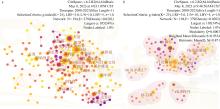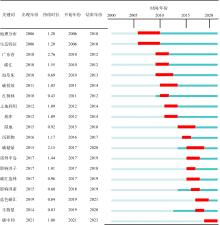Journal of Tropical Oceanography ›› 2024, Vol. 43 ›› Issue (5): 58-68.doi: 10.11978/2023168CSTR: 32234.14.2023168
• Marine Biology • Previous Articles Next Articles
CiteSpace-based visualization analysis of carbon sink research progress in typical blue carbon ecosystems of Guangdong Province
ZHANG Tong1,2( ), LING Juan1,3,4,5, YUE Weizhong1, WANG Youshao1, CHENG Hao1, SUN Hongyan2, HUANG Xiaofang1,3,5, LIANG Tongyin1,6, ZHOU Weiguo1,3, DONG Junde1,3,4,5(
), LING Juan1,3,4,5, YUE Weizhong1, WANG Youshao1, CHENG Hao1, SUN Hongyan2, HUANG Xiaofang1,3,5, LIANG Tongyin1,6, ZHOU Weiguo1,3, DONG Junde1,3,4,5( )
)
- 1. CAS Key Laboratory of Tropical Marine Bio-resources and Ecology, Chinese Academy of Sciences, Guangdong Provincial Key Laboratory of Applied Marine Biology, South China Sea Institute of Oceanology, Chinese Academy of Sciences, Guangzhou 510301, China
2. College of Marine Sciences, South China Agricultural University, Guangzhou 510640, China
3. Key Laboratory of Tropical Marine Biotechnology of Hainan Province, Sanya Institute of Ocean Eco-Environmental Engineering, Sanya 572000, China
4. Guangdong Provincial Observation and Research Station for Coastal Upwelling Ecosystem, South China Sea Institute of Oceanology, Chinese Academy of Sciences, Shantou 515041, China
5. Tropical Marine Biological Research Station in Hainan, Chinese Academy of Sciences, Sanya 572000, China
6. University of Chinese Academy of Sciences, Beijing 100049, China
-
Received:2023-11-06Revised:2023-12-22Online:2024-09-10Published:2024-10-10 -
Supported by:Marine Economy Development Project of Guangdong Province(GDNRC[2023] 43); Sanya Science and Technology Innovation Project(2022KJCX07); Guangdong Basic and Applied Basic Research Foundation(2023A1515012124); Science Technology Planning Project of Guangdong Province of China(2021B1212050023); Science Technology Planning Project of Guangdong Province of China(2023B1212060047); Hainan Provincial Natural Science Foundation of China(422QN440); National Natural Science Foundation of China(41676163); National Natural Science Foundation of China(42276160); National Natural Science Foundation of China(42206129); Hainan Province Science and Technology Special Fund(ZDYF2023SHFZ172)
Cite this article
ZHANG Tong, LING Juan, YUE Weizhong, WANG Youshao, CHENG Hao, SUN Hongyan, HUANG Xiaofang, LIANG Tongyin, ZHOU Weiguo, DONG Junde. CiteSpace-based visualization analysis of carbon sink research progress in typical blue carbon ecosystems of Guangdong Province[J].Journal of Tropical Oceanography, 2024, 43(5): 58-68.
share this article
Add to citation manager EndNote|Reference Manager|ProCite|BibTeX|RefWorks
Tab. 1
Ranking of authors sorted by the number of their published papers on the studies of carbon sinks of Blue Carbon Ecosystems in Guangdong Province"
| 作者 | 发文量/篇 | 作者单位 |
|---|---|---|
| 李婷婷 | 3 | 广东省地质调查院 |
| 林广旋 | 3 | 广东湛江红树林国家级自然保护区管理局 |
| 许方宏 | 3 | 广东湛江红树林国家级自然保护区管理局 |
| 陈桂珠 | 3 | 中山大学环境科学研究所 |
| 刘宇 | 2 | 综合开发研究院(中国·深圳) |
| 匡耀求 | 2 | 中国科学院广州地球化学研究所 |
| 华国栋 | 2 | 广东省林业调查规划院 |
| 吴林芳 | 2 | 广州林芳生态科技有限公司 |
| 高天伦 | 2 | 中国林业科学研究院 |
| 黄小平 | 2 | 中国科学院南海海洋研究所 |
Tab. 2
Ranking of research institutes sorted by the number of their published papers on the studies of carbon sinks of Blue Carbon Ecosystems in Guangdong Province"
| 机构 | 发文量/篇 | 占比/% |
|---|---|---|
| 广东海洋大学 | 8 | 8.51 |
| 中国科学院华南植物园 | 6 | 6.38 |
| 中山大学 | 6 | 6.38 |
| 广东省林业调查规划院 | 6 | 6.38 |
| 厦门大学 | 5 | 5.31 |
| 广州大学 | 5 | 5.31 |
| 广东湛江国家级红树林自然保护区管理局 | 4 | 4.25 |
| 中国林业科学研究院 | 3 | 3.19 |
| 中国科学院大学 | 3 | 3.19 |
| 华南农业大学 | 3 | 3.19 |
| [1] |
陈超美, 陈悦, 侯剑华, 等, 2009. CiteSpace Ⅱ: 科学文献中新趋势与新动态的识别与可视化[J]. 情报学报, 28(3): 401-421.
|
|
|
|
| [2] |
陈光程, 2021. 我国成功交易首个“蓝碳”碳汇项目[J]. 应用海洋学学报, 40(3): 555-556.
|
|
|
|
| [3] |
陈小龙, 狄乾斌, 侯智文, 等, 2023. 海洋碳汇研究进展及展望[J]. 资源科学, 45(8): 1619-1633.
doi: 10.18402/resci.2023.08.10 |
|
doi: 10.18402/resci.2023.08.10 |
|
| [4] |
陈瑶瑶, 张雅松, 娄铎, 等, 2019. 广东英罗湾不同潮位红树林-滩涂系统碳密度差异[J]. 生态环境学报, 28(6): 1134-1140.
doi: 10.16258/j.cnki.1674-5906.2019.06.008 |
|
|
|
| [5] |
陈悦, 陈超美, 刘则渊, 等, 2015. CiteSpace知识图谱的方法论功能[J]. 科学学研究, 33(2): 242-253.
|
|
|
|
| [6] |
高天伦, 2018. 广东省雷州附城主要红树林群落碳储量及其影响因子[D]. 北京: 中国林业科学研究院:16-19.
|
|
|
|
| [7] |
广东省生态环境厅, 2023. 广东省红树林碳普惠方法学[Z]. 广州: 广东省生态环境厅: 8-13.
|
|
DEPARTMENT OF ECOLOGY AND ENVIRONMENT OF GUANGDONG PROVINCE, 2023. Carbon Inclusive Methodology for Mangrove Forests in Guangdong Province[Z]. Guangzhou: Guangdong Provincial Department of Ecology and Environment: 8-13 (in Chinese).
|
|
| [8] |
韩广轩, 王法明, 马俊, 等, 2022. 滨海盐沼湿地蓝色碳汇功能、形成机制及其增汇潜力[J]. 植物生态学报, 46(4): 373-382.
doi: 10.17521/cjpe.2021.0264 |
|
|
|
| [9] |
贺炬成, 2021. 广东省红树林湿地生态系统碳汇研究综述[J]. 中国林业产业, (12): 54-57.
|
|
|
|
| [10] |
胡懿凯, 徐耀文, 薛春泉, 等, 2019. 广东省无瓣海桑和林地土壤碳储量研究[J]. 华南农业大学学报, 40(6): 95-103.
|
|
|
|
| [11] |
华国栋, 庄礼凤, 李家祥, 等, 2021. 广东台山镇海湾红树林国家湿地公园土壤有机碳含量及其影响因素分析[J]. 林业与环境科学, 37(6): 118-123.
|
|
|
|
| [12] |
黄妃本, 陈纯秀, 罗勇, 2015. 碳汇监测与计量技术在广东红树林生态系统的应用研究[J]. 广东林业科技, 31(4): 101-105.
|
|
|
|
| [13] |
黄灵玉, 2015. 广东红树林土壤有机碳分布特征及其影响因素研究[D]. 桂林: 广西师范学院:20-22.
|
|
|
|
| [14] |
黄小平, 黄良民, 李颖虹, 等, 2006. 华南沿海主要海草床及其生境威胁[J]. 科学通报, (S3): 114-119.
|
|
|
|
| [15] |
江小芳, 2020. 中国红树林植被和土壤碳储量及其影响因子[D]. 厦门: 厦门大学:25-37.
|
|
|
|
| [16] |
黎夏, 叶嘉安, 王树功, 等, 2006. 红树林湿地植被生物量的雷达遥感估算[J]. 遥感学报, 10(3): 387-396.
|
|
|
|
| [17] |
李政, 严欣恬, 李杨帆, 等, 2022. 构建粤港澳大湾区特色蓝碳交易市场探析[J]. 特区实践与理论, (5): 56-60.
|
|
|
|
| [18] |
廖宝文, 张乔民, 2014. 中国红树林的分布、面积和树种组成[J]. 湿地科学, 12(4): 435-440.
|
|
|
|
| [19] |
林德明, 陈超美, 刘则渊, 2011. 共被引网络中介中心性的Zipf-Pareto分布研究[J]. 情报学报, 30(1): 76-82.
|
|
|
|
| [20] |
刘镇杭, 刘大海, 池源, 等, 2023. 基于自然的海岸带蓝碳增汇措施及其技术体系研究[J]. 海岸工程, 42(1): 13-24.
|
|
|
|
| [21] |
吕华当, 2016. 广东: 海洋生物固碳养殖初见成效[J]. 海洋与渔业, (5): 18.
|
|
|
|
| [22] |
覃国铭, 张靖凡, 周金戈, 等, 2023. 广东省红树林土壤碳储量及固碳潜力研究[J]. 热带地理, 43(1): 23-30.
doi: 10.13284/j.cnki.rddl.003606 |
|
doi: 10.13284/j.cnki.rddl.003606 |
|
| [23] |
任玉正, 刘松林, 罗红雪, 等, 2023. 海草床退化与修复对其沉积物有机碳储存的影响过程[J]. 科学通报, 68(22): 2961-2972.
|
|
|
|
| [24] |
生态环境部, 2021. 关于统筹和加强应对气候变化与生态环境保护相关工作的指导意见[R]. 北京: 生态环境部:5-6.
|
|
MINISTRY OF ECOLOGY AND ENVIRONMENT, 2021. Guiding Opinions on Co-ordinating and Strengthening the Work Related to Climate Change Response and Ecological Environment Protection[R]. Beijing: Ministry of Ecology and Environment: 5-6 (in Chinese).
|
|
| [25] |
仝川, 罗敏, 陈鹭真, 等, 2023. 滨海蓝碳湿地碳汇速率测定方法及中国的研究现状和挑战[J]. 生态学报, 43(17): 6937-6950.
|
|
|
|
| [26] |
肖明, 陈嘉勇, 李国俊, 2011. 基于CiteSpace研究科学知识图谱的可视化分析[J]. 图书情报工作, 55(6): 91-95.
|
|
|
|
| [27] |
许方宏, 张进平, 张倩媚, 等, 2012. 广东湛江高桥三个天然红树林的土壤碳库[J]. 价值工程, 31(15): 5-6.
|
|
|
|
| [28] |
杨熙, 何静, 郭治明, 2023. 南海区海草床生态调查研究[M]. 北京: 海洋出版社:19-45.
|
|
|
|
| [29] |
杨熙, 余威, 何静, 等, 2022. 海南黎安港海草床碳储量评估[J]. 海洋科学, 46(11): 116-125.
|
|
|
|
| [30] |
张莉, 郭志华, 李志勇, 2013. 红树林湿地碳储量及碳汇研究进展[J]. 应用生态学报, 24(4): 1153-1159.
|
|
|
|
| [31] |
邹建明, 王树功, 朱远辉, 2010. 广东低碳生态示范省建设背景下的红树林保护与恢复: 2010中国可持续发展论坛暨中国可持续发展研究会学术年会[C]. 济南: 2010中国可持续发展论坛2010年专刊 (二).
|
|
|
|
| [32] |
|
| [33] |
|
| [34] |
|
| [35] |
|
| [36] |
|
| [37] |
|
| [38] |
INTERGOVERNMENTAL PANEL ON CLIMATE CHANGE, 2019. Special report on the ocean and cryosphere in a changing climate[R]. Geneva: IPCC: 497-500.
|
| [39] |
|
| [40] |
|
| [41] |
|
| [42] |
|
| [43] |
|
| [44] |
doi: S0025-326X(15)30047-3 pmid: 26428624 |
| [45] |
|
| [46] |
|
|
||









